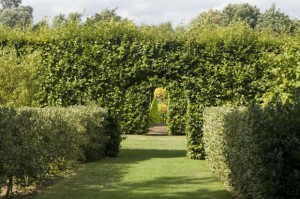Here are a few useful tips that will help you to maintain your hedging and achieve a beautiful result with the minimum of effort, especially if using a petrol hedge trimmer
Tips For New Plantings
When you plant a new hedging, you should cut it back by :-
– One third for evergreens such as box
– To six inches in height for vigorous hedging plants such as hawthorn and privet
The next year just trim lightly before cutting back by one third again in the following year (this should be done during the dormant period).
In the third year, you will be able to start shaping your plants if you are going for a formal effect.
Tips For Trimming Formal Plantings.
 Attach string to four posts which should be positioned at each corner of the area you are going to cut. Put the strings at the height you want to trim to. You can do this in sections – although obviously you will only be able to attach a string down each side or around one end if you are using the sectional method and so will not have four strings on your posts. The string will provide you with a guide as to height and width. Check your work as you go, don’t wait until you get to the end of the line as mistakes are easier to rectify before you have gone too far.
Attach string to four posts which should be positioned at each corner of the area you are going to cut. Put the strings at the height you want to trim to. You can do this in sections – although obviously you will only be able to attach a string down each side or around one end if you are using the sectional method and so will not have four strings on your posts. The string will provide you with a guide as to height and width. Check your work as you go, don’t wait until you get to the end of the line as mistakes are easier to rectify before you have gone too far.
If you have a sprung lawn rake, give your hedge a few good bats with the back of it after trimming. That way, all those annoying little twigs that have always sprung out by the next morning, spoiling the effect, can be dealt with there and then!
If you have any thick branches, tackle these with lopping shears before starting trimming. It is much better to deal with these first and get them all done, than having to keep stopping and starting your trimmer.
Formal hedging should always be cut so that the top is slightly narrower than the base. This gives a slight angle to the sides and the method is the convention in formal gardens and is called ‘cutting to a batter’.
Topiaries will require trimming during the growing season, all other types can normally be cut at the end of the season, going into winter and again in early summer.
Always remove the clippings, brush soft clippings off onto a tarpaulin spread on the ground as this will save time, avoid leaving clippings that could cause fungal or mould growth that might infect your plants.

